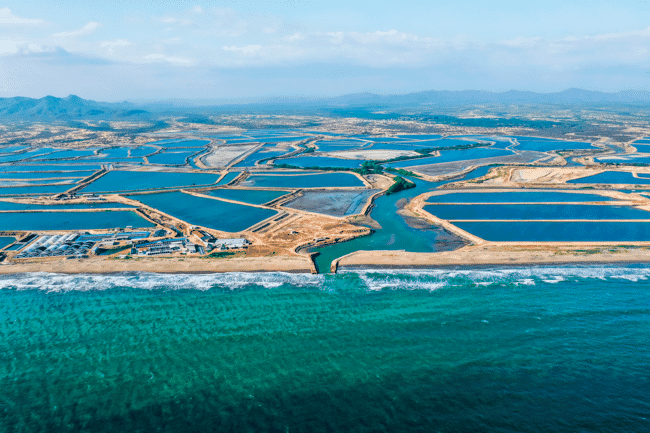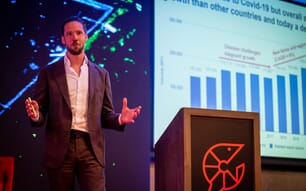
Campbell is chairing the Shrimp x Tech x Innovation: Farm Optimization session at this year's Global Shrimp Forum
Called Shrimp x Tech x Innovation: Farm Optimization, and taking place at 10.45 on 4 September, the session will be led by Andrew Campbell, CEO of AQ1 Systems, who is well-placed to lead the discussions, given that the company’s sound-based feeding technology has now been adopted by many of the world’s top shrimp producers – with over 40,000 feeders currently operational in over 15 countries.
The session will feature startups and innovators sharing new approaches – from AI and IOT to digital tools for improved control and prediction of production outcomes.– with the CEOs of Tomota, Jala*, ShrimpL and Kampi, showcasing how their technologies are enabling more resilient, efficient and profitable shrimp farming operations.
Following their pitches, Santosh Kumar from the International Finance Corporation will lead a critical Q&A, probing into the companies’ value propositions and exploring the challenges they face in raising fresh funding rounds.
“The goal is to give farmers a glimpse of what’s coming – and what’s already here,” Campbell says. “But we also want to cut through the noise. Not all tech is ready. Not all of it makes sense.”
Campbell sees the forum as an opportunity for meaningful dialogue between tech companies, farmers, and investors.
“Shrimp farming is still in the early stages of its digital journey,” he says. “But the pace is accelerating. Forums like this help align expectations and build trust.”
Surfing the new wave
Campbell has spent much of his aquaculture career in the salmon sector and, as he points out, technological adoption in shrimp farming has traditionally lagged behind salmon. But that’s changing.
“There’s a wave of digitisation hitting shrimp farming now,” he says. “People are starting to understand the power of data – of collecting it, analysing it and making decisions from it.”
He likens the shift to what happened in dairy or poultry farming a generation ago.
“They went from being hands-on, manual operations to data-rich, optimised production systems. Shrimp farming is heading the same way,” he suggests.
That wave is being driven by a mix of economic pressure, environmental regulation and investor interest in ESG performance. Farmers are being asked to do more with less – fewer resources, less labour, lower impact – and tech can be used to help.
“Labour is a challenging one,” says Campbell. “In many countries, skilled labour is hard to find. Automation helps farmers manage more ponds by aiding their best people to improve production performance.”
A patchwork industry
While technology is advancing globally, the rate and nature of adoption vary significantly by region.
"Ecuador is the leading country in terms of adoption and now has a very strong culture of feeding automation, and other countries like Saudi Arabia and Mexico have also taken it on in the last few years,” Campbell notes.
In Latin America other countries such as Honduras and Nicaragua have also adopted the technology well. Meanwhile, others are playing catch-up.
"In Asia it is still relatively early. There’s a lot of interest there, but it’s still in the education phase in terms of the farmers understanding the value,” he observes.

Gaps to be filled
While many technologies are already helping the shrimp sector improve, Campbell believes there are only a handful of areas in which high tech hardware can still really move the needle.
"Feed is still 50 to 60 percent of your cost, so it’s the first place to start. If you can get your feeding right, that flows through to everything else – survival, growth, water quality,” he says.
AQ1’s flagship technology uses acoustics to achieve this.
“Shrimp make noise when they’re feeding. It’s subtle, but it’s there,” explains Campbell. “Our systems use hydrophones – underwater microphones – to monitor those feeding sounds in real-time. That data tells us exactly when to feed and when to stop.”
Given that overfeeding can pollute water, stress animals and waste money, while underfeeding stunts growth and reduces harvest yields, AQ1’s system can make a huge difference to farmers’ bottom lines.
“It takes the guesswork out,” says Campbell. “You’re no longer relying on a farm worker’s instinct or routine. It’s a data-driven decision made in the moment, every moment.”
The impact is measurable. “Farmers see faster growth, better survival, and significant feed savings,” he adds.
Looking beyond feed, Campbell also sees huge potential in tools that can estimate shrimp biomass – measuring how many shrimp are in a pond and how big they are is not easy in turbid shrimp ponds. It’s an area that several companies, are actively working on, using tools such as computer vision and sonar.
"Biomass estimation is the big one. If you don’t know what biomass you’ve got, then how can you feed it properly, manage your harvest, or even know how much money you’ve made?" he says.
However, he sees huge scope for improvements in software terms – notably in regards to data integration.
“Right now, farmers use different tools for different things – spreadsheets, apps, sensors – but it’s all disconnected. There’s a need for a central platform where everything comes together. We’re working on that too,” he reflects.
Focus on the fundamentals
Despite the hype around new tech, Campbell urges farmers to stay grounded and focused.
“At the end of the day, this game is about producing as many tonnes per hectare per year as you can, at the lowest cost per kilo,” he emphasises.
“A lot of farmers get excited about new tech, but they focus on the gadget rather than the problem it’s solving. Technology should be a tool – not the goal. Start with the outcome you want, then find the tech that helps you get there,” he adds.
He’s also a believer in taking small steps, especially for smaller farmers.
"You don’t have to do the whole farm. Start with a couple of ponds, see the results, then expand. That’s how most of our customers started,” he advises.
Despite the relatively slow speed of tech adoption in some regions, with innovation accelerating and margins tightening, it’s likely that the shrimp farms of the future will need to be not just bigger, but smarter, too.
*Jala is part of Hatch Blue's investment portfolio, but The Fish Site retains editorial independence.

© Jala





